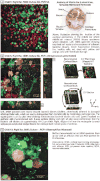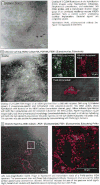Direct detection of bacterial biofilms on the middle-ear mucosa of children with chronic otitis media
- PMID: 16835426
- PMCID: PMC1885379
- DOI: 10.1001/jama.296.2.202
Direct detection of bacterial biofilms on the middle-ear mucosa of children with chronic otitis media
Abstract
Context: Chronic otitis media (OM) is a common pediatric infectious disease. Previous studies demonstrating that metabolically active bacteria exist in culture-negative pediatric middle-ear effusions and that experimental infection with Haemophilus influenzae in the chinchilla model of otitis media results in the formation of adherent mucosal biofilms suggest that chronic OM may result from a mucosal biofilm infection.
Objective: To test the hypothesis that chronic OM in humans is biofilm-related.
Design, setting, and patients: Middle-ear mucosa (MEM) biopsy specimens were obtained from 26 children (mean age, 2.5 [range, 0.5-14] years) undergoing tympanostomy tube placement for treatment of otitis media with effusion (OME) and recurrent OM and were analyzed using microbiological culture, polymerase chain reaction (PCR)-based diagnostics, direct microscopic examination, fluorescence in situ hybridization, and immunostaining. Uninfected (control) MEM specimens were obtained from 3 children and 5 adults undergoing cochlear implantation. Patients were enrolled between February 2004 and April 2005 from a single US tertiary referral otolaryngology practice.
Main outcome measures: Confocal laser scanning microscopic (CLSM) images were obtained from MEM biopsy specimens and were evaluated for biofilm morphology using generic stains and species-specific probes for H influenzae, Streptococcus pneumoniae, and Moraxella catarrhalis. Effusions, when present, were evaluated by PCR and culture for evidence of pathogen-specific nucleic acid sequences and bacterial growth, respectively.
Results: Of the 26 children undergoing tympanostomy tube placement, 13 (50%) had OME, 20 (77%) had recurrent OM, and 7 (27%) had both diagnoses; 27 of 52 (52%) of the ears had effusions, 24 of 24 effusions were PCR-positive for at least 1 OM pathogen, and 6 (22%) of 27 effusions were culture-positive for any pathogen. Mucosal biofilms were visualized by CLSM on 46 (92%) of 50 MEM specimens from children with OME and recurrent OM using generic and pathogen-specific probes. Biofilms were not observed on 8 control MEM specimens obtained from the patients undergoing cochlear implantation.
Conclusion: Direct detection of biofilms on MEM biopsy specimens from children with OME and recurrent OM supports the hypothesis that these chronic middle-ear disorders are biofilm-related.
Figures



References
-
- Post JC, Preston RA, Aul JJ, et al. JAMA. 1995;273:1598–1604. - PubMed
-
- Aul JJ, Anderson KW, Wadowsky RM, et al. A comparative evaluation of culture and PCR for the detection and determination of persistence of bacterial strains and DNAs in the Chinchilla laniger model of otitis media. Ann Otol Rhinol Laryngol. 1998;107:508–513. - PubMed
-
- Rayner MG, Zhang Y, Gorry MC, Chen Y, Post JC, Ehrlich GD. Evidence of bacterial metabolic activity in culture-negative otitis media with effusion. JAMA. 1998;279:296–299. - PubMed
Publication types
MeSH terms
Substances
Grants and funding
LinkOut - more resources
Full Text Sources
Other Literature Sources
Medical
Miscellaneous

